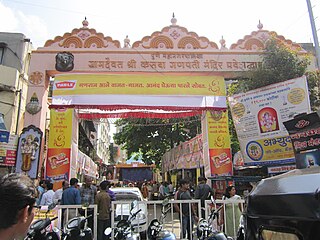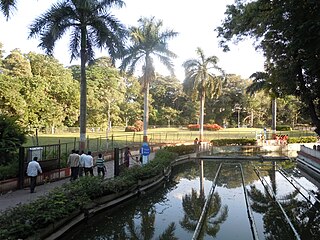
Pune, previously spelled in English as Poona, is a city in Maharashtra state in the Deccan plateau in Western India. It is the administrative headquarters of the Pune district, and of Pune division. According to the 2011 Census of India, Pune is the ninth-most populous city in India with a population of 3.1 million residents within the city limits, and 7.2 million residents in the metropolitan region, making it the eight-most populous metropolitan area in India. The city of Pune is part of Pune Metropolitan Region. Pune is one of the largest IT hubs in India. It is also one of the most important automobile and manufacturing hubs of India. Pune is often referred to as "Oxford of the East" because of its highly regarded educational institutions. It has been ranked "the most liveable city in India" several times.

Shaniwar Wada is a historical fortification in the city of Pune, India.

The Kasba Ganapati refers to both a particular murti of the god Ganapati in Pune, India, as well as to the temple built around the murti. The Kasba Ganapati is the presiding deity (gramadevata) of Pune.
Wai is a town in Satara district of Maharashtra state in India. Located on the Krishna River, Wai was a prominent town during the Peshwa era. Two important Marathi Brahmin from ruling families had their origins here: Rani Lakshmibai of Jhansi and Gopikabai, wife of Nanasaheb Peshwa.

Kasba Peth or Kasba is the oldest residential part, "Peth " (locality), in Pune, India. It is adjacent to the historic Shaniwar Wada palace-fort. Kasba Peth was the first Peth to be established sometime during the 5th century, and is the oldest area in Pune. It is called the "Heart of Pune City". In the history of Pune, the city was once known as "Kasbe Pune".
The Dashabhuja Temple is a Hindu temple in Pune, in the Maharashtra state of India. This temple was once owned by Sardar Haripant Phadke, a Sardar of Peshwa and was later donated to the Peshwas as dowry. Dashabhuja Ganapati temple is visited by thousands of devotees every day and the number increases during Ganesh Chaturthi. The idol of Ganpati or Ganesh seen here has his elephant trunk resting on his right-hand side, which is supposed to be rarer and more sacred than other forms of the Ganesh idol.
Nashirabad is a small town in Jalgaon district in the northern Maharashtra state in India. It was named after Nasiruddin Badshah. The earlier name of the town was Solnimbhore. This was due to fact that the town had 16 Hanuman temples and 16 main doors.

The Dagadusheth Halwai Ganapati temple is a Hindu Temple located in Pune and is dedicated to the Hindu god Ganesh. The temple is visited by over hundred thousand pilgrims every year. Devotees of the temple include celebrities and chief ministers of Maharashtra who visit during the annual ten-day Ganeshotsav festival. The main Ganesh idol is insured for sum of ₹10 million (US$130,000). It celebrated 130 years of its Ganapati in 2022.

Shaniwar Peth is a historic ward in the centre of the Indian city of Pune. Shaniwar means Saturday in Marathi and other Indian languages.

Sarasbaug is a major landmark in the city of Pune in India. The place where the park now stands was once occupied by a small lake. However, the lake dried up and was later developed into Sarasbaug. The whole 25-acre (10 ha) complex is known as Sarasbaug. The Ganesh temple in Saras Baug is also known as Talyatla Ganapati which translates as the Ganapati of the lake.

Ranjangaon Ganpati also known as Shri Mahaganpati Temple is a Hindu temple dedicated to Lord Ganesha, one of the most revered deities in Hinduism. Situated in the village of Ranjangaon within the Shirur taluka of Pune district, Maharashtra, India. It is one of the eight Ashtavinayak temples venerating Lord Ganesha, bearing immense religious importance in Hinduism.

Bharat Itihas Sanshodhak Mandal, popularly known as Itihas Sanshodhak Mandal or just 'Mandal', is an Indian institute providing resources and training for historical researchers. It is located at Pune in Maharashtra state. The institute was founded in 1910 by the veteran Indian historian V. K. Rajwade and Sardar K. C. Mehendale. V. K. Rajwade founded Bharat Itihas Sanshodhak Mandal in Pune, on 7 July 1910 to facilitate historical research.

Mahatma Phule Mandai is the biggest retail vegetable market in the city of Pune, India. The market is housed in an iconic building from the British colonial era in the Shukrawar Peth locality in the center of the city.
Tulshibaug is an area in Pune City in the state of Maharashtra, India. It is located in the old city area. Its main features are a historic temple precinct and a large market.
Sadashiv Peth is an area located in Pune, Maharashtra. It was founded by Madhavrao Peshwa in honour of Sadashivrao Peshwa. It was initially planned for the military and laid out in squares with broad streets.
Appa Balwant Chowk is a popular crossroads in the Shaniwar Peth neighborhood of Pune, India that is particularly noted for the concentration of bookshops in the area. It is also the site of the 15th century Tambdi Jogeshwari temple.

Shri Laxmi Narsimha Temple is a Hindu temple dedicated to Narasimha, an avatar of Vishnu, located in western India, in Pune district of the state of Maharashtra. The temple is located at the confluence of Bhima river and Nira river, at the south eastern tip of Pune district, in Indapur taluka.

Shrimant Bhausaheb Rangari Ganapati is a Ganesha idol in Pune. It was the first Sarvajanik Ganesha of India.













